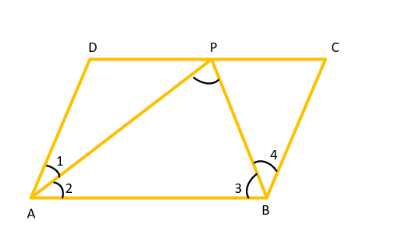
In parallelogram ABCD, the bisector of angle A meets DC in P and
Answer
488.7k+ views
Hint: To solve this problem, we will first start with constructing a figure, then using basic properties of parallelogram, i.e., opposite angles are supplementary, we will get an equation. After that we will use the given condition, and by applying the values, we will get our required answer.
Complete step-by-step answer:
We have been given that in the parallelogram ABCD, the bisector of angle A meets DC in P and also,
Let us construct a figure, using the above information to understand better.

We know that in a parallelogram opposite angles are supplementary.
Therefore, from the figure,
Now, from the figure we get that,
Also,
So, on putting the values in
We know that, sum of angles in a triangle equals to
So, in triangle APB.
Now from
Thus,
Note: To solve such questions, students should always construct a figure first. And also, in the solution, we have taken, BP is the bisector of angle B, because, in the parallelogram, we know that opposite sides are equal and parallel, therefore, AD
Complete step-by-step answer:
We have been given that in the parallelogram ABCD, the bisector of angle A meets DC in P and also,
Let us construct a figure, using the above information to understand better.

We know that in a parallelogram opposite angles are supplementary.
Therefore, from the figure,
Now, from the figure we get that,
Also,
So, on putting the values in
We know that, sum of angles in a triangle equals to
So, in triangle APB.
Now from
Thus,
Note: To solve such questions, students should always construct a figure first. And also, in the solution, we have taken, BP is the bisector of angle B, because, in the parallelogram, we know that opposite sides are equal and parallel, therefore, AD
Recently Updated Pages
Master Class 9 General Knowledge: Engaging Questions & Answers for Success

Master Class 9 English: Engaging Questions & Answers for Success

Master Class 9 Science: Engaging Questions & Answers for Success

Master Class 9 Social Science: Engaging Questions & Answers for Success

Master Class 9 Maths: Engaging Questions & Answers for Success

Class 9 Question and Answer - Your Ultimate Solutions Guide

Trending doubts
Fill the blanks with the suitable prepositions 1 The class 9 english CBSE

Difference Between Plant Cell and Animal Cell

Given that HCF 306 657 9 find the LCM 306 657 class 9 maths CBSE

The highest mountain peak in India is A Kanchenjunga class 9 social science CBSE

What is the difference between Atleast and Atmost in class 9 maths CBSE

What is pollution? How many types of pollution? Define it




